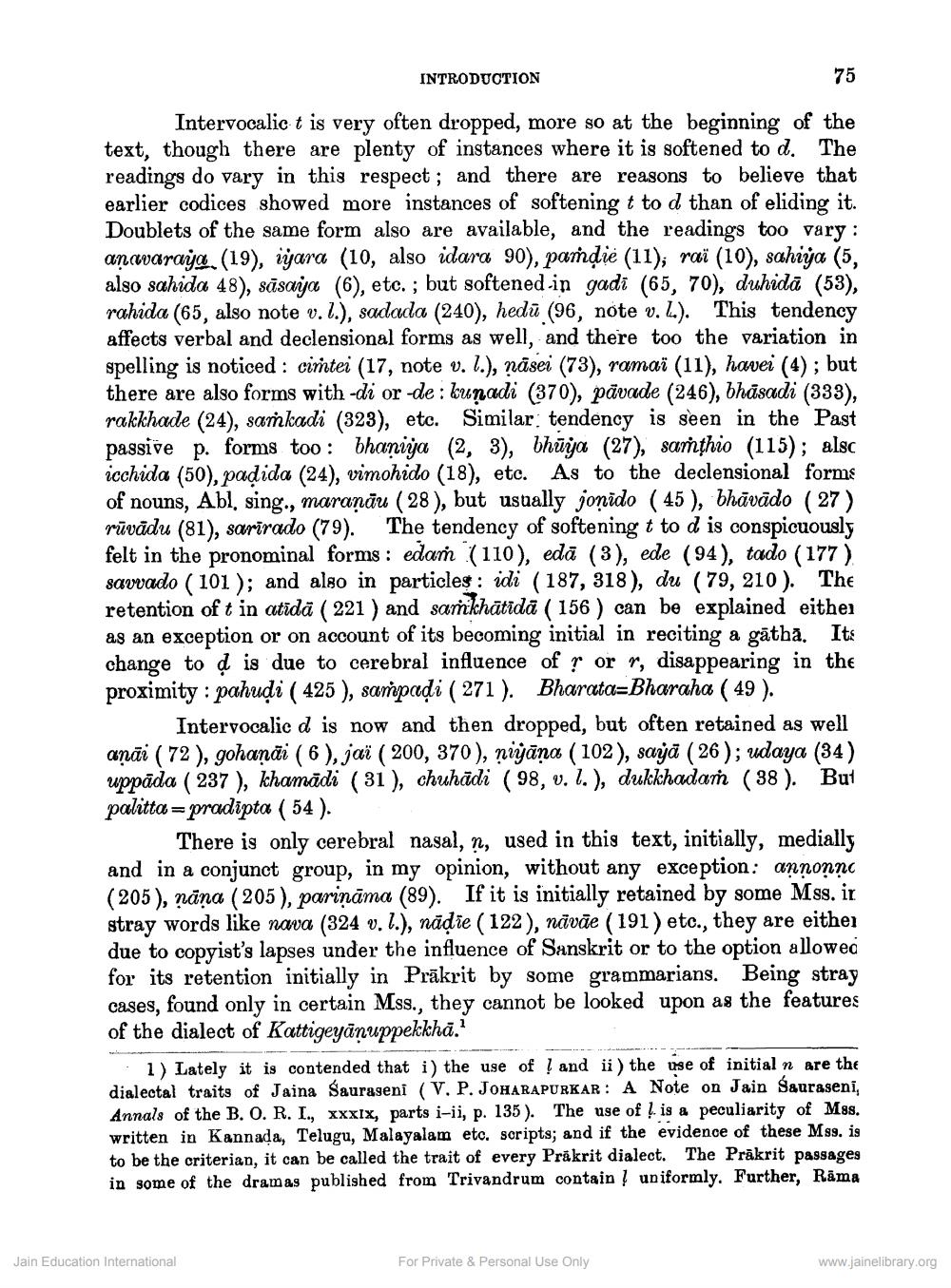________________
INTRODUCTION
75
Intervocalict is very often dropped, more so at the beginning of the text, though there are plenty of instances where it is softened to d. The readings do vary in this respect, and there are reasons to believe that earlier codices showed more instances of softening t to d than of eliding it. Doublets of the same form also are available, and the readings too vary : anavaraya (19), ijara (10, also idara 90), pandie (11); raï (10), sahija (5, also sahida 48), sāsaja (6), etc. ; but softened-in gadi (65, 70), duhidā (53), rahida (65, also note v.1.), sadada (240), hedū (96, note v. L). This tendency affects verbal and declensional forms as well, and there too the variation in spelling is noticed: cirtei (17, note v. l.), nāsei (73), ramaï (11), havei (4); but there are also forms with -di orde: kunadi (370), pāvade (246), bhāsadi (333), rakkhade (24), saṁkadi (323), etc. Similar tendency is seen in the Past passive p. forms too : bhaniya (2, 3), bhūya (27), samthio (115); alsc icchida (50), padida (24), vimohido (18), etc. As to the declensional forms of nouns, Abl. sing., maraņāu ( 28 ), but usually jonido ( 45 ), bhāvādo (27) rūvādu (81), sarirado (79). The tendency of softening t to d is conspicuously felt in the pronominal forms: edam (110), edā (3), ede (94), tado (177) savvado (101); and also in particles : idi (187, 318), du (79, 210). The retention of t in atīdā ( 221 ) and samkhātida ( 156 ) can be explained either as an exception or on account of its becoming initial in reciting a gatha. Its change to d is due to cerebral influence of porr, disappearing in th proximity : pahudi ( 425), sampaļi (271). Bharata=Bharaha ( 49 ).
Intervocalic d is now and then dropped, but often retained as well aņāi ( 72 ), gohaņāi ( 6 ), jaï ( 200, 370), nijāņo (102), sajā (26); udaya (34) uppāda ( 237 ), khamādi ( 31 ), chuhādi (98, v. l.), dukkhadam ( 38 ). But palittar pradipta ( 54).
There is only cerebral nasal, n, used in this text, initially, medially and in a conjunct group, in my opinion, without any exception: annonno (205), ņāna (205), parināma (89). If it is initially retained by some Mss. ir stray words like nava (324 v. l.), nādie (122), nāvāe (191) etc., they are either due to copyist's lapses under the influence of Sanskrit or to the option allowed for its retention initially in Prākrit by some grammarians. Being stray cases, found only in certain Mss., they cannot be looked upon as the features of the dialect of Kattigeyānuppekkha.
1 ) Lately it is contended that i) the use of land ii) the use of initial n are the dialectal traits of Jaina Sauraseni (V. P. JOHARAPURKAR: A Note on Jain Sauraseni, Annals of the B. O. R. I., xxxix, parts i-ii, p. 135). The use of ļ. is a peculiarity of M8s. written in Kannada, Telugu, Malayalam etc. scripts; and if the evidence of these Mss. is to be the criterian, it can be called the trait of every Prakrit dialect. The Prākrit passages in some of the dramas published from Trivandrum contain l uniformly. Further, Rāma
Jain Education International
For Private & Personal Use Only
www.jainelibrary.org




